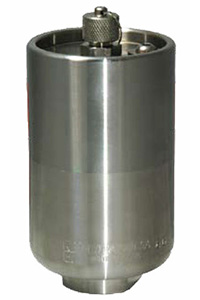SFU Series
- SFU o-ring
- SFU wing nut
- Dust cap
- Loading valve
- Bleeder valve
- Cartridge
- Case
SFV & SFVM Series
Pulsation Damper For Piston Pump
- 6″ or 8″ suction gasket
- 6″ or 8″ grooved coupling
- Dust cap
- Loading valve
- Bleeder valve
- Cartridge
- Case
Integrated Equipment offers a range of Drilling and Production Pulsation Dampeners that are unique in design and construction. Integrated Dampeners are available from 1 gallon to 20 gallon capacities and in pressure ranges from 285 psi to 7500 psi.The bodies for both styles are of single piece construction which eliminates the possibility of weld failures in the field. A pulsation damper removes pulses only from the line downstream of the damper – not upstream. That's why it is always recommended that discharge damper installations to be made as close to pump discharge nozzles as possible. Precharge Pressure Levels for K and IP-Series Pulsation Dampeners (Hydril) Gas precharge pressure must be measured with. The Hydril K-P Series Pulsation Dampener/Surge Stabilizer should be mounted in the vertical position (refer to Figure 1- 3 and 1-4 for mounting options) with the mating flange con- nection at the bottom. The discharge dampener should be mounted as close as possible to the discharge port of the pump. TenarisHydril running manual Product EXPLORE 'Running Manual, runningmanual, running guidelines, guidelines' Wedge 623® Product EXPLORE 'wedge 623, wedge 623 connection, integral semi-flush, premium, intermediate casing, production casing, liners, tie-backs, dopeless, 600, integral semiflush, tsh wedge 623, wedge623, premium connection'.
SFT Series
- HPG-1 gasket (Nitrile or EPDM)
- Dust cap
- Loading valve
- Bleeder valve
- Cartridge
- Case
SFM Series
- SFM o-rings (2 required)
- SFM wingnut
- Dust cap
- Loading valve
- Bleeder valve
- Cartridge
- Case
- SFM wingnut screw
CHARGE TO 80%- 90% OF SUCTION PRESSURE OR THE MAXIMUM CHARGE PRESSURE OF THE CARTRIDGE, WHICHEVER IS LESS. THIS IS ONLY AN APPROXIMATION.
(YOU MAY FIND IT NECESSARY TO DECREASE THE PRESSURE IN THE SUCTION CARTRIDGE TO ACHIEVE OPTIMUM PUMP PERFORMANCE.)
- Shut down pump and relieve line pressure from discharge side before closing suction valve. After discharge line is relieved of pressure, close suction line valve and drain suction line.
- Open bleeder valve 'A'.
- Remove loading valve protector cap 'B'.
- Remove cap from loading valve 'C'.
- Loosen safety nut 'D' three full turns.
- Using NITROGEN ONLY, charge the cartridge through loading valve 'C' to the recommended operating pressure (90% of suction pressure). (DO NOT EXCEED MAXIMUM CARTRIDGE CHARGE PRESSURE).
- Tighten safety nut 'D' on loading valve 'C'.
- Replace loading valve protector cap 'B'
- Open suction valve. When air from bleeder valve 'A' is evacuated, close bleeder valve 'A'.

- Shut down pump and relieve line pressure.
- Open bleeder valve 'A'.
- Remove loading valve protector cap 'B'.
- Remove cap from loading valve 'C'.
- Loosen safety nut 'D' three full turns.
- Using NITROGEN ONLY charge the cartridge through loading valve 'C' to correct charge pressure (use chart below).
NOTE: DO NOT EXCEED MAXIMUM CARTRIDGE CHARGE PRESSURE (ON CASE LABEL). - Tighten safety nut 'D' on loading valve 'C' and replace cap.
- Replace loading valve protector cap 'B'.
- Open suction valve. When air from bleeder valve 'A' is evacuated, close bleeder valve 'A'.
Hydril Pulsation Dampener Manual Diagram
WARNING
Hydril Pulsation Dampener Manual Hydraulic
THE USE OF ANY GAS OTHER THAN NITROGEN IS EXTREMELY DANGEROUS.

(YOU MAY FIND IT NECESSARY TO DECREASE THE PRESSURE IN THE SUCTION CARTRIDGE TO ACHIEVE OPTIMUM PUMP PERFORMANCE.)
- Shut down pump and relieve line pressure from discharge side before closing suction valve. After discharge line is relieved of pressure, close suction line valve and drain suction line.
- Open bleeder valve 'A'.
- Remove loading valve protector cap 'B'.
- Remove cap from loading valve 'C'.
- Loosen safety nut 'D' three full turns.
- Using NITROGEN ONLY, charge the cartridge through loading valve 'C' to the recommended operating pressure (90% of suction pressure). (DO NOT EXCEED MAXIMUM CARTRIDGE CHARGE PRESSURE).
- Tighten safety nut 'D' on loading valve 'C'.
- Replace loading valve protector cap 'B'
- Open suction valve. When air from bleeder valve 'A' is evacuated, close bleeder valve 'A'.
- Shut down pump and relieve line pressure.
- Open bleeder valve 'A'.
- Remove loading valve protector cap 'B'.
- Remove cap from loading valve 'C'.
- Loosen safety nut 'D' three full turns.
- Using NITROGEN ONLY charge the cartridge through loading valve 'C' to correct charge pressure (use chart below).
NOTE: DO NOT EXCEED MAXIMUM CARTRIDGE CHARGE PRESSURE (ON CASE LABEL). - Tighten safety nut 'D' on loading valve 'C' and replace cap.
- Replace loading valve protector cap 'B'.
- Open suction valve. When air from bleeder valve 'A' is evacuated, close bleeder valve 'A'.
Hydril Pulsation Dampener Manual Diagram
WARNING
Hydril Pulsation Dampener Manual Hydraulic
THE USE OF ANY GAS OTHER THAN NITROGEN IS EXTREMELY DANGEROUS.
K20 Pulsation Dampener
NEVER ATTEMPT TO CHARGE OR PRE-CHARGE A CARTRIDGE OUTSIDE OF THE PULSATION STABILIZER CASE.
FOR PROPER CHARGING PROCEDURES REFER TO THE SUCTION OR DISCHARGE CHARGING GUIDE.
